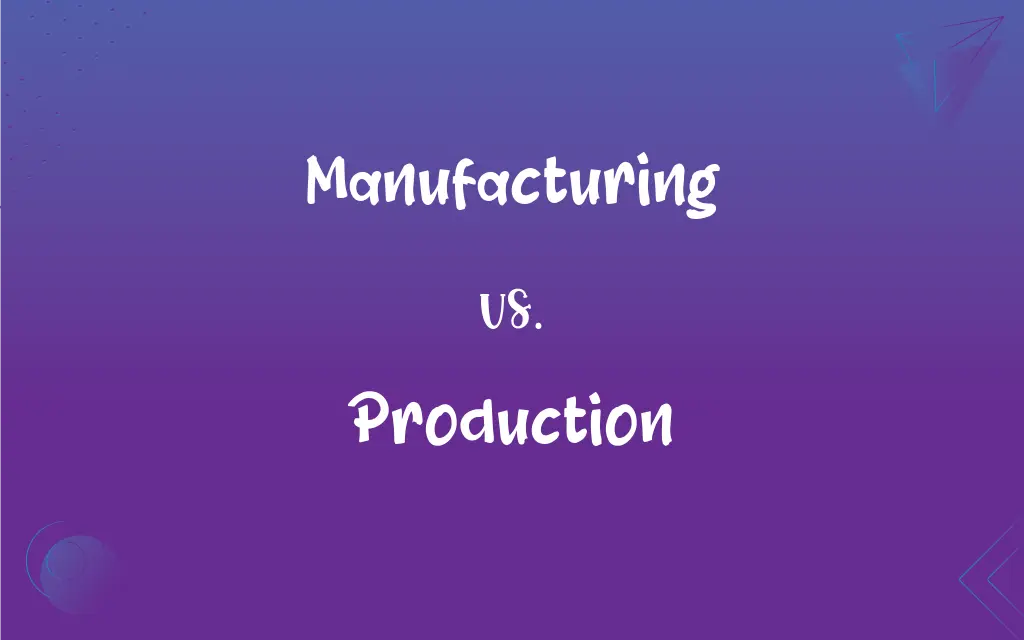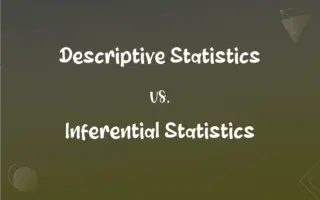Manufacturing vs. Production: What's the Difference?
Edited by Janet White || By Harlon Moss || Updated on October 10, 2023
Manufacturing is the process of making products from raw materials, while production encompasses all processes of creating goods and services.

Key Differences
Manufacturing and production are terms often used interchangeably, but they differ in scope. Manufacturing specifically refers to converting raw materials into finished products through various processes.
Production, on the other hand, encompasses a broader range. It not only includes manufacturing but also covers non-manufacturing processes, such as agriculture, mining, and services.
When speaking of manufacturing, the focus narrows to the use of machinery, labor, and raw materials to create tangible goods. It's about physical transformation — turning wood into furniture or metal into cars.
In contrast, production isn't limited to physical goods. A music studio producing a song or a chef producing a meal are both part of the production realm, but neither involves manufacturing in the traditional sense.
In business terms, manufacturing is just one subset of production. Organizations often have production departments overseeing the entirety of goods and services creation, while the manufacturing department looks after only the fabrication part.
ADVERTISEMENT
Comparison Chart
Scope
Narrower, involving making products
Broader, covering all creation processes
Involves
Physical transformation of materials
Any activity that results in a product or service
Output
Tangible goods
Tangible and intangible products
Examples
Making furniture, cars, electronics
Farming, mining, music creation, consulting
Industries
Automotive, electronics, textile
Agriculture, entertainment, services, mining
ADVERTISEMENT
Manufacturing and Production Definitions
Manufacturing
The creation of goods on a large scale using machinery.
Advanced robotics has revolutionized manufacturing in many industries.
Production
The overall process of creating goods and services.
The production of their latest smartphone model faced delays due to supply chain issues.
Manufacturing
The process of turning raw materials into finished goods using tools, machines, and labor.
The company specializes in the manufacturing of high-quality furniture.
Production
All activities involved in making a product available.
The movie’s production took nearly two years from inception to release.
Manufacturing
A systematic approach to converting raw components into sellable products.
The decline of manufacturing jobs in the region led to an economic downturn.
Production
Generating goods or services often on a scale for commercial purposes.
The farmer increased the production of corn to meet the new market demands.
Manufacturing
The act of producing goods from raw or semi-finished materials.
The manufacturing sector showed strong growth this quarter, leading to a rise in exports.
Production
The creation or manufacture of goods in large quantities.
The production of electric vehicles has surged in recent years.
Manufacturing
Fabricating products for sale using various processes like forming, machining, and assembly.
The city was once a hub for shoe manufacturing.
Production
The amount of something, often a commodity, that is created over a specific period.
The production of honey depends largely on the health and population of the beehives.
Manufacturing
To make or process (a raw material) into a finished product, especially by means of a large-scale industrial operation.
Production
The act or process of producing
Timber used for the production of lumber and paper.
Manufacturing
To make or process (a product), especially with the use of industrial machines.
Production
The fact or process of being produced
A movie going into production.
FAQs
Can services be included in manufacturing?
No, manufacturing pertains specifically to the creation of tangible physical goods.
Is every kind of production considered manufacturing?
No, only production processes that involve creating tangible goods are considered manufacturing.
What does production encompass?
Production encompasses all processes involved in creating goods and services, whether tangible or intangible.
Are there sectors where manufacturing and production overlap?
Yes, in sectors like the automobile industry, manufacturing (making cars) is a subset of overall production (including design, testing, etc.).
Can production refer to non-physical goods?
Yes, production can refer to both tangible goods and intangible services.
Is manufacturing only related to large-scale creation?
Manufacturing typically refers to large-scale creation, but it can be on any scale, as long as tangible goods are produced.
What does production capacity mean?
Production capacity refers to the maximum amount of goods or services that can be produced with the available resources.
What does manufacturing involve?
Manufacturing involves converting raw materials into finished goods using machinery and labor.
What are the main elements of manufacturing?
Main elements include raw materials, machinery, labor, and processes that create finished goods.
How does manufacturing contribute to an economy?
Manufacturing contributes by adding value, creating jobs, boosting exports, and stimulating growth.
Does production always involve physical labor?
Not always, production, especially in services, can involve intellectual or creative efforts.
Can a single firm be involved in both manufacturing and production?
Yes, a firm can be involved in manufacturing physical goods and also engage in other types of production.
Is farming considered manufacturing or production?
Farming is considered a type of production, not manufacturing, as it doesn’t involve converting raw materials into goods.
Can a service industry have a manufacturing division?
Yes, if a service industry also creates physical goods, it can have a manufacturing division.
What is custom manufacturing?
Custom manufacturing involves creating specific, customized products based on individual customer specifications.
Can a business be involved in production without manufacturing?
Yes, businesses like consultancy firms or entertainment companies are involved in production without manufacturing.
Does production only occur in factories?
No, production can occur in various settings, including offices, studios, farms, and online platforms.
What is mass production in manufacturing?
Mass production refers to manufacturing large quantities of standardized products efficiently.
Is freelance content creation considered production?
Yes, content creation, even by freelancers, is a form of intangible production.
How is technology impacting production and manufacturing?
Technology, like automation and AI, is enhancing efficiency, reducing costs, and innovating processes in both production and manufacturing.
About Author
Written by
Harlon MossHarlon is a seasoned quality moderator and accomplished content writer for Difference Wiki. An alumnus of the prestigious University of California, he earned his degree in Computer Science. Leveraging his academic background, Harlon brings a meticulous and informed perspective to his work, ensuring content accuracy and excellence.
Edited by
Janet WhiteJanet White has been an esteemed writer and blogger for Difference Wiki. Holding a Master's degree in Science and Medical Journalism from the prestigious Boston University, she has consistently demonstrated her expertise and passion for her field. When she's not immersed in her work, Janet relishes her time exercising, delving into a good book, and cherishing moments with friends and family.
































































